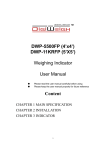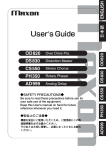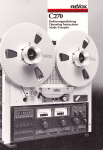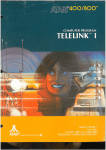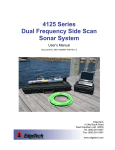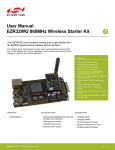Download Atari 410 Program Recorder Operator`s Manual
Transcript
., " A Warner Communications CompanyO INTRODUCTION UNPACKING NOTE: It is important to read all instructions carefully before attempting to operate the AT ARI® 410™ Program Recorder. Improper use may result in damage to the system. This package contains: The ATARI 410 Program Recorder is used with a cassette to hold blocks of software too large to be maintained in cartridge form. Programs, recorded on magnetic tape, are copied by the computer from the tape into RAM memory. Once in memory, these programs can be run or modified by the user according to instructions given through the Keyboard. Working in BASIC language, the user can also type his own programs into memory from the Keyboard, then store them on tape for later use or modifications. To set up your ATARI 410 Program Recorder: 1. PI ug the data cord (permanently attached to your recorder) into the jack labeled PERIPHERAL on the side panel of the AT ARI Console. II • An ATARI® 410™ • A peripheral data cord permanently attached to the recorder SAFETY NOTE: When plugged into a 115 volt wall outlet, the ATARI 410 Program Recorder contains dangerous voltage. To prevent shock hazard, it should never be immersed in water or have liquid spilled on it. It contains no "user serviceable parts" and should be opened only by a qualified technician. Do not use the ATARI 410 Program Recorder out-of doors. 2. • .D --- - . - ------------- - Plug your recorder power cord into the jack labeled AC on the side of the recorder and into an ordinary wall socket. Some models will have a power cord permanently attached to the recorder. To operate your ATARI 410 Program Recorder: CARTRIDGE • ; Program Recorder • A recorder power cord _":.~- ATARI(\) 400™ • • • • • ·----2.-) * ~.~ • PLAY enables the computer to read the cassette. Note that the tape will not move until the computer starts reading from the tape. RECORD enables the computer to save programs or data on the cassette. Hold the RECORD key down and push PLAY to enable record mode. STOP disengages the play or record modes. Always STOP the ATARI 410 Program Recorder when it is not in use to prevent deformation of the tape. EJECT opens the cassette door and releases the cassette. NOTE: On some machines, STOP and EJECT are the same key. Press the key once to stop the PLAY/RECORD function; press it again to eject the cassette. ADVANCE fast winds the cassette forward. REWIND fast winds the cassette backward. Some machines may have a PAUSE key. PAUSE leaves the cassette machine in the PLAY or RECORD mode, but disengages the pinch roller from the tape. Press the PAUSE key once to disengage the tape; press PAUSE again to reenable PLAY/RECORD. The counter reset button sets the tape position counter to zero. See the section that refers to making multiple recordings on a tape. ., POSITIONING THE TAPE FOR RECORDING OR PLAYBACK The recommended procedure is to place only one program per side, starting at the beginning of the side. If you want to record more than one program per tape side, start by rewinding the tape. Then reset the counter to 000 and wind the tape forward at least 10 counts past the end of the last program on the tape. Always write down the first and last counter numbers so you can find what you have recorded. To read back the program, rewind the cassette, set the counter to 000 and wind it forward to exactly the same count where you began the recording. If this fails, trying again with a count one or two off in either direction will probably work. Tape counters will vary (sometimes a great deal!) from recorder to recorder. It may therefore be very difficult to find a program in the middle of a tape on another machine. To read prerecorded ATARI cassettes, simply start at the beginning of the tape. Insert the tape so that the label of the side you want can be seen. NOTE: Make sure that any tape you intend to use for recording has less than 7 seconds of leader (nonmagnetized tape that is wound on the reel AHEAD of the actual recording tape). On playback, the computer will ignore the first 9 seconds of tape (or leader), but at the end of 9 seconds, the computer MUST be reading the tape. If the leader is too long the computer will be trying to read data where no data exists, and an error 143 (checksum Error) or 138 (Device Timeout) may be displayed on the screen. PREVENTION OF ACCIDENTAL ERASING To prevent accidental recording or erasing and to preserve previous recordings, break off the two tabs on the back of the cassette. By doing so, your set's built-in Accidental Erasure Prevention Device will function automatically. If side 1 is facing upward, then tab NO.1 must be broken off to prevent accidental erasure (see diagram). If the opposite surface (side 2) is facing upward, tab No.2 must be broken off. If a tab was previously broken off, you may still erase or record by temporarily placing cellophane tape over the missing tab opening. All prerecorded tapes are sold with these tabs broken off. t TAB No.2 , TAB No.1 SAVING & RETRIEVING COMPUTER PROGRAMS FROM THE COMPUTER TO A CASSETTE TAPE FROM A CASSETTE TAPE TO THE COMPUTER 1. Lift the cartridge door and insert the COMPUTING LANGUAGE BASIC cartridge into the ATARI 400 or ATARI 800 computer. (Use the LEFT CARTRIDGE slot on the ATARI 800 System.) 1. 2. Press the POWER switch on the side of the console ON. 2. 3. Write your program using the keyboard. 3. 4. Insert a blank cassette tape into the Program Recorder. 5. Push REWIND to locate the beginning of the tape, or to locate the end of a preceding program using the counter number. Note the counter number if you have more than one program recorded per side, for future location of the program. 6. 7. 8. Using the keyboard, type CSAVE, then press ';!ii"W' . You will hear two beeps. Next push RECORD and PLAY simultaneously on the ATARI 410 Program Recorder. Press ';!ii"i;V1 again on the keyboard. (You will hear a series of tones as your program is copied.) When the tape stops, your program has been recorded on the cassette tape. READY will be displayed on the screen. Push STOP on the ATARI 410 Program Recorder. 9. It is good programming practice to ALWAYS make a duplicate CSAVE "just in case." If this prevents losing just one long programming effort, it will justify the small investment in extra time many times over! Lift the cartridge door and insert the COMPUTING LANGUAGE BASIC cartridge into the ATARI 400 or ATARI 800 computer. (Use the LEFT CARTRIDGE slot on the ATARI 800 system.) Press the POWER switch on the side of the console ON. Insert a prerecorded cassette tape or your own program cassette tape, into the ATARI 410 Program Recorder. (Label reading toward you). 4. Push REWIND to locate the beginning of the tape, or locate the beginning of the program you want using the counter number. 5. Using the keyboard, type CLOAD, then press 'iijiQ;it1 . You will hear one beep. 6. Push PLAY on the ATARI 410 Program Recorder. Press Ijijii@l again on the keyboard. 7. When the tape stops, your program has been transferred from the cassette tape to the computer. READY will be displayed on the screen. Push STOP on the ATARI 410 Program Recorder. Type: RUN or LIST to see your program displayed. For a cross-reference, see the recording and transferring instructions in sections 8 and 12 of your ATARI400 Operator's Manual, or sections 8 and 15 of your ATARI 800 Operator's Manual. For further information on loading and saving programs with your ATARI 410 Program Recorder, see the ATARI BASIC Reference Manual (Chapter 5). THE ATARI® EDUCATIONAL SYSTEM 1. Lift the cartridge door and insert the Educational System Master Cartridge into the AT AR I 400 or ATARI 800 Computer. (Use the LEFT CARTRIDGE slot on the ATARI 800 System.) 2. Press the POWER switch on the side of the console ON. 3. Insert an educational cassette tape into the ATARI 410 Program Recorder with the label reading toward you. 4. Press REWIND on the Program Recorder, wait for the tape to stop, then press STOP. 5. Push PLAY on the Program Recorder. 6. Push ED on the computer console. Use the tape counter reset button on the Program Recorder to mark the beginning and the end of each program. Pressing the button resets the counter to 000. Use the ADVANCE button to move the tape forward, if necessary. 7. The program will begin playing on the screen with the audio portion beginning simultaneously. If the program doesn't start, check all connections, and retrace the previous steps. 8. The computer keyboard is used to respond to questions. For three-option, multiple-choice questions: Press 1 if the left answer is correct. Press 2 if the middle answer is correct. Press 3 if the right answer is correct. For two-option, multiple-choice questions: Press 1 if the left answer is correct. Press 3 if the right answer is correct. THE PROGRAM WILL NOT ADVANCE AUTOMATICALLY UNTIL YOU HAVE CHOSEN THE CORRECT ANSWER. Some frames in the ATARI Educational System are held on the screen to allow you time to read them. This is usually indicated by Push or Ptgo (Push to Go) at the bottom of the screen, but sometimes no indication is given. Type 1, 2, or 3 to continue. On rare occasions, the tape may stop when it shouldn't. To restart it, type 1, 2, or 3 or press i.t6ii %'ti;liiiii and then press ED. If you wish to review a section of a lesson, you may rewind the tape. However, when you start the tape in the middle of a section of data, you may see gibberish characters on the screen. This occurs because the machine cannot read data on the tape until after it comes up to speed. It will recover by itself. If you want to see the information that was lost, rewind the tape a bit more. If you want to start with the second lesson on a tape, fast wind to about the middle of the tape. An extra long blank gap is provided between the lessons to aid you. CARING FOR TAPE CASSETTES To protect your valuable data, please take care to: • Keep cassettes in their protective boxes when not in use. • Keep cassettes dry. • Avoid extreme heat or cold. • Avoid touching the tape in the cassette. • Avoid pulling the tape out of the cassette. (The tape may be wound back into the cassette if necessary by carefully turning the tape hub with a six-sided pen.) • Keep cassettes away from magnets, electrical or electronic equipment, telephones, etc. New cassettes should be fast wound and rewound to "loosen the stack" and eliminate static electricity from the manufacturing process. Ca~settes kept in storage for a long time should also be fast wound and rewound periodically. Even high quality cassettes may stick or bind after extensive use. In some cases this can be cured by firmly striking each side of the cassette flat against a table. CARE OF YOUR ATARI 410 RECORDER Periodic cleaning of the tape path is very important for relible operation of your AlARI 410 Program Recorder. Any good tape-head cleaner (available at most record or HI-FI stores), or 95% denatured alcohol may be used. Wet a quality wood-handled cotten swab with the cleaner and wipe the tape heads, capstan and pinch roller, being careful not to leave bits of cotton behind. The capstan and pinch roller are most easily cleaned while turning. To do this, insert the COMPUTING LANGUAGE BASIC cartridge into the AlARI 400 or AlARI 800 computer and turn the POWER on. Press PLAY on the Program Recorder, then type CLOAD, and then press ';!iiii@i. When the computer beeps, press 'i!iiii@1 on the computer console. The capstan should now turn for about twenty seconds. To clean the exterior of your AlARI 410 Program Recorder, disconnect it from the computer and the wall socket,. then wipe with a damp cloth. Mild detergent may be used, but avoid using strong solvents or cleaners on the plastic case. COTTON SWAB~ I h@ a @(J ~ L PINCH ROLLER CAPSlAN RECORD-PLA YBACK HEAD ERASE HEAD POSITIONING THE TAPE FOR RECORDING OR PLAYBACK NOTE: For some versions of the Operating System Software supplied with the ATARI 400 or ATARI 800, a special procedure is required to position the tape for recording or playback. To determine if your machine is one of these, insert the ATARI BASIC (COMPUTING LANGUAGE) Cartridge, and type the following BASIC command: PRINT PEEK (65528) 'dil@1 If the computer responds 255, use the instructions on this sheet. It is recommended that you place this page in your ATARI 410 Program Recorder Operator's Manual. If the computer responds with any other number than 255, use the instructions preprinted in your ATARI 410 Program Recorder Operator's Manual. To record programs or data with your ATARI 410 Program Recorder, the recommended procedure is to place only one program per side, starting at the splice at the beginning of the side. Place the tape in the Program Recorder and REWIND to the beginning of the appropriate side. Then remove the cassette and, by turning a six-sided pen in the take-up hub, wind the tape forward until the splice between the plastic leader and the oxide-coated tape is visible in the center hole of the cassette shell. Then reinsert the cassette and set the tape counter on the ATARI 410 Program Recorder to 000. To read back the program, position the cassette at the splice (as above), set the counter to 000, and wind it forward to exactly the same count where you began the recording. If this fails, trying again with a count one or two off in either direction will probably work. Tape counters will vary (sometimes a great deal!) from recorder to recorder. It may therefore be very difficult to find a program in the middle of a tape on another machine. To read prerecorded AT ARI cassettes, start at the leader-tape spl ice (as described above). Insert the tape so that the label of the side you want can be seen. When reading ATARI Educational System tapes, it is not necessary to start at the spl ice -simply rewind the tape to the beginning of the side you want to play. If you want to record more than one program per tape side, position the tape at the splice (as above). Then reset the counter to 000 and wind the tape forward at least 10 counts past the end of the last program on the tape. Always write down the first and last counter numbers so you can find what you have recorded. JI\. ATARI® C014810 REV. 2 A Warner Communications Company ~ MANUAL © 1979 AlARI, INC. PRINTED IN U.S.A.







